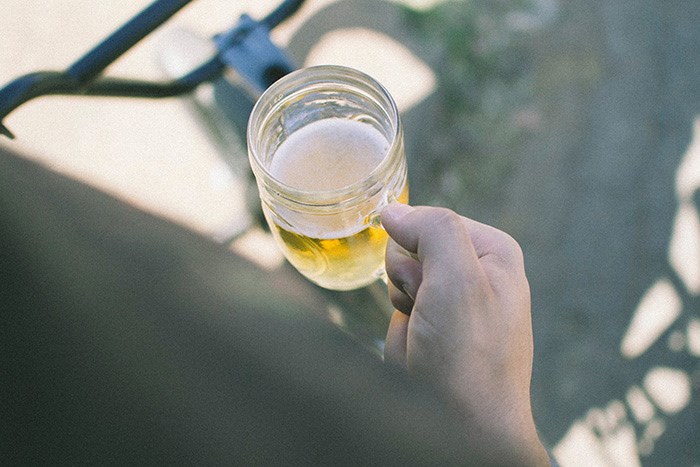 Photo: Unsplash / Fabio Alves
Photo: Unsplash / Fabio Alves
It’s safe to say the craft beer revolution has been fought and won. If you live in Vancouver or Victoria—or just about any reasonably-sized town in southern B.C.—you probably have a craft brewery within walking distance.
But until recently, our brothers and sisters in the north had few options for good beer—it was Bud or Canadian, and that’s about it.
Thankfully the craft beer revolution has come to liberate them from the clutches of macro swill, with five breweries opening in the past year and two more ready to open any day now. These breweries are on the frontlines, fighting the good fight to convert the masses to locally made beer, often with local ingredients, like birch syrup or haskap berry.
The blossoming beer scene in the north is also a great excuse to get up there and visit the other 80 per cent of the province we city folk rarely experience. And that’s a damn shame, because as I found out, Northern B.C. is completely, ridiculously beautiful, and packed full of surprises.
So with my very patient wife and my somewhat less patient 16-month-old son in tow, I set out to explore our northern beer frontier over 10 days in spring.
Into the North Country
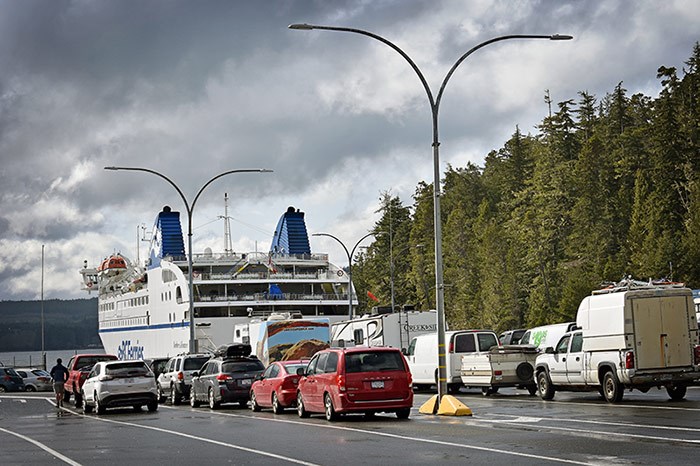 Photo: Rob Mangelsdorf
Photo: Rob Mangelsdorf
First thing I realized when planning this trip: B.C. is like really, really freaking big. So we decided to let B.C. Ferries do the hard work while we enjoyed the scenery. At 22 hours long, the Port Hardy to Prince Rupert ferry is nothing like what you’ve experienced popping between the Island and the Mainland.
The Northern Expedition plies the same scenic route up as many of those fancy Alaska cruises; the 500-km journey up the Inside Passage snakes through narrow fjords, past abandoned former cannery towns and dozens if not hundreds of waterfalls. Make sure you find yourself a window seat so you can enjoy the show: we saw pods of dolphins, humpback whales, and a soaring bald eagle with a salmon clutched tightly in its talons. We were only a day into our trip and we already managed to reach Maximum British Columbia.
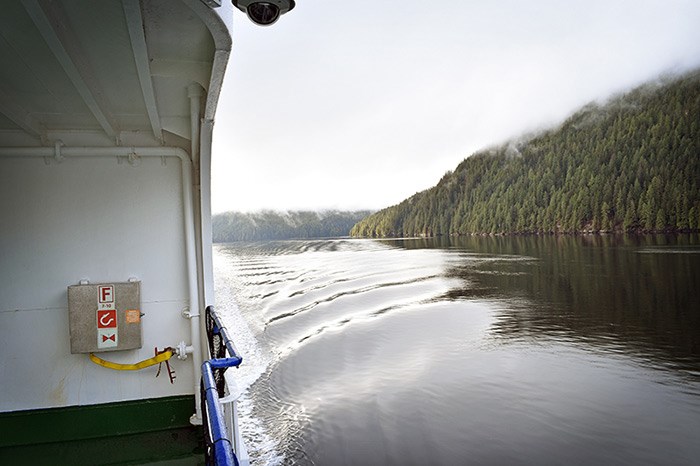 Photo: Rob Mangelsdorf
Photo: Rob Mangelsdorf
Unlike the southern routes, the cafeteria is licenced, and while the beer selection leaves much to be desired, you can purchase wine by the litre, which is very convenient.
Fare ranges from about $100-175 for foot passengers, depending on the season, with vehicle rates $225-400—which is a bargain when you consider how much those cruises cost for the same scenery. Four-berth staterooms can be purchased for the overnight trip (highly recommended), starting at $85.
Misty mountain hops
The ferry deposits us in the quirky coastal city of Prince Rupert, situated at end of the Yellowhead Highway (or at the beginning, depending on your perspective).
Soaked in rain (it’s Canada’s rainiest city, in fact) and steeped in history, this busy port town has become a magnet for working class families in recent years, as have many northern towns. This is the wild edge of North America and that wildness is evident as we stroll around the colourful and quirky town surrounded by rainforest and rugged mountains. There’s an independent, creative streak that runs through Prince Rupert; most businesses are locally owned, drive-through fast food franchises are refreshingly sparse, and funky cafés and restaurants abound.
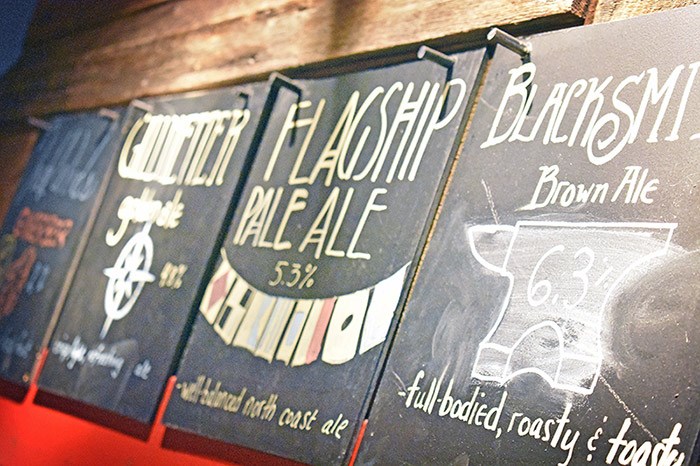 Wheelhouse Brewing. Photo: Rob Mangelsdorf
Wheelhouse Brewing. Photo: Rob Mangelsdorf
“There’s a real culture of supporting your own up here,” says Craig Outhet, brewer and co-owner of Wheelhouse Brewing Co.
Located in the charming and walkable Cow Bay neighbourhood north of downtown, Wheelhouse’s tasting room is rustic and cosy, with semaphore flags and fishing floats hanging from the wooden rafters. The beers have come a long way since it first opened in 2013, and while Gillnetter Golden Ale is still the brewery’s best seller, increasingly, the locals are warming up to hoppier beers like the tropical Kazu Maru IPA (6.7% ABV, 75 IBU), a lovely light-bodied, citrus fruit-forward East Coast-ish IPA with Idaho 7, Mosaic and Summit hops.
“We wanted to tread lightly at first,” says Outhet. “We take it as our job to introduce things to people, and there’s trust there now. People are game to try anything now.”
Following the highway inland through the Coast Mountains and along the impossibly wide and impossibly beautiful Skeena River brings us to Terrace. This town of about 12,000 is nestled among snow-capped peaks and raging rivers, which form much of the tourism draw for the area—world-class skiing, kayaking and fishing.
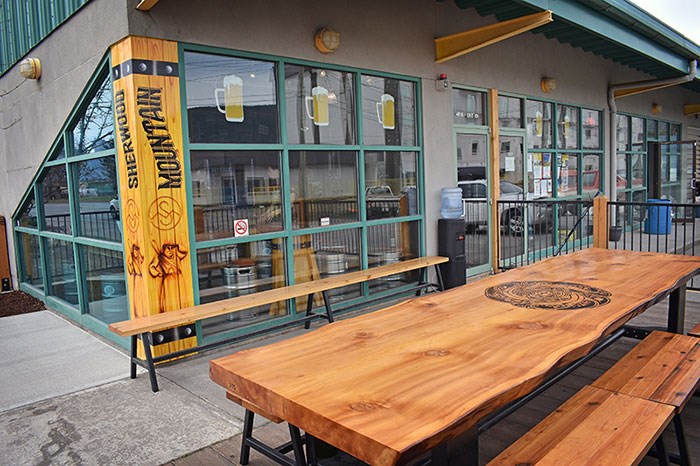 Photo: Rob Mangelsdorf
Photo: Rob Mangelsdorf
Sherwood Mountain Brewhouse has gained a loyal following here since it opened in 2014 with its focus on German-style lagers, with owner Darryl Tucker and brewer Jake Lambert both having trained in Berlin. In fact, four of the seven beers on tap the day I as there were lagers.
“This is a lager town and 60 per cent of what we sell are lagers,” says Lambert. “We focus on easy-drinking beers everyone can enjoy.”
The Munich Lager (5.1% ABV, 12 IBU), Sherwood’s take on the classic dunkel, was the standout of the beers I tried, with balanced notes of caramel and roast malt.
As we made our way east, we stopped in the Hazeltons—the triplet towns of Hazelton, New Hazelton and South Hazelton—home to the Gitxsan First Nation and Canada’s northernmost hop farm. Here the Bulkley River meets the Skeena, forming dramatic gorges and canyons as they wind their way through the valley under the watchful gaze of the imposing mountain known locally as Stekyawden. Due to a quirk of geography, the valley is considerably warmer and drier than surrounding areas.
Hazelton’s downtown is straight out of the Old West, with 19th century wooden, false-fronted buildings lining the streets and a restored sternwheeler serving as the town hall. Just around the corner is the ‘Ksan Historical Village and Museum, which features a recreation of an ancient Gitxsan village on the site where First Nations have lived for millennia.
The village has more than half a dozen traditional carved longhouses, totems and a museum with hundreds of preserved artifacts, including cedar bent boxes, ceremonial masks, button blankets, shaman’s regalia and fishing and hunting gear. Everywhere you look in Hazeltons, you’re confronted with jaw-dropping scenery. It was all the more startling to me considering I had no idea this place even existed. I got the feeling from the locals they didn’t want word getting out about their little slice of heaven. Sorry! (Not sorry!)
The mountains open up into the broad Bulkley Valley as we continue eastward to Smithers, less than an hour from Hazelton. You could be forgiven for thinking you’d stumbled into an East Kootenays ski town like Golden or Revelstoke, what with the faux Bavarian architecture and Hudson Bay Mountain Resort looming overhead. Indeed, Smithers has been referred to as the Nelson of the North, and with two new breweries, this young and funky town is clearly on the right path, beer-wise.
In fact, Smithers was home to the first northern craft brewery, the now defunct Plan B brewing, which was named nanobrewery of the year by Northwest Brewing News before it went out of business in 2013, a victim of its own success.
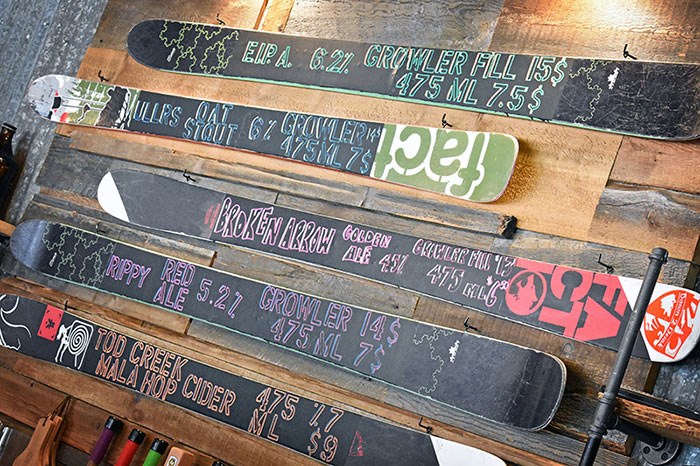 Photo: Rob Mangelsdorf
Photo: Rob Mangelsdorf
But Plan B’s legacy still lingers in Smithers, with the brewery’s display fridge prominently displayed at the newly opened Bulkley Valley Brewery, with the old Plan B beer list still painted on the side.
Like many in the north, BVB brewer and Ontario native Jeff Harrop says he moved to Smithers to enjoy the great outdoors, specifically, the world-class fishing.
“You get to do what you want up here,” he says. “It’s a four season paradise; there’s fishing, mountain biking, skiing, hiking, snowmobiling. That’s why more and more people are moving up here. We’re spoiled up here.”
BVB offers classic West Coast styles in its solar-powered, après-themed tasting room. The easy-drinking Broken Arrow Golden Ale (4.5% ABV 18 IBU) has proven popular with locals; refreshing and fruity, it’s reminiscent of an Australian summer ale with its pilsner malt base and late addition hops.
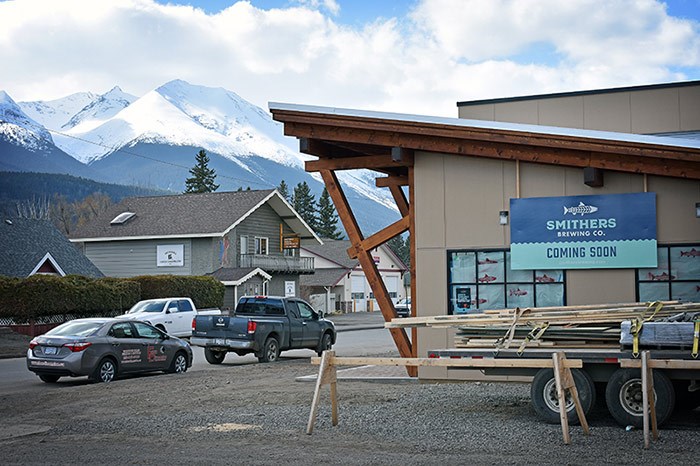 Photo: Rob Mangelsdorf
Photo: Rob Mangelsdorf
A block away at the soon-to-be opened Smithers Brewing Co., brewer Cam McKeigan says while he plans to have mainstays to keep the locals happy, he’s looking forward “to going off the deep end.”
“It’s the North, there’s no rules up here,” he says. “I think people up here are ready for things like sour beers.”
Smithers Brewing’s gorgeous local timber-framed building is one of the few purpose built craft breweries anywhere in B.C. and when it opens (any day now), it will have 10 taps fed by its brand new 1,200-litre brewhouse.
If the brett-fermented passion fruit sour ale I tried is any indication of what’s to come, this brewery alone could be worth the trip to Smithers.
On a Plain
Passing through the historic hamlets of Telkwa and Houston, the snow-capped peaks give way to the low rolling hills and lakes of Cariboo-Chilcotin plateau. Following the Nechako River through countless farms and ranches brings us to Prince George, the capital of the north with a population of close to 80,000.
Like many northern towns, the 1990s were tough on Prince George: the bottom fell out of the lumber industry, mills closed, unemployment and crime rose. However, recent years have seen the city rebound in a major way. The University of Northern B.C.—which was ranked as Canada’s best small undergraduate university by Maclean’s in 2015 and 2016—has brought young, educated people to the city, as has affordable housing and close proximity to the oil and gas fields. Those who left for the big city decades ago are coming back, and they are bringing their families with them. The rebounding economy in the north means local residents have disposable income, and Prince George’s food and drink scene is blossoming as a result.
The revitalization of the city’s downtown has been key to the city’s turnaround. Where there were once empty storefronts and dodgy nightclubs, there are now art galleries, comedy clubs, cute cafés, legitimately impressive restaurants, and of course, craft beer.
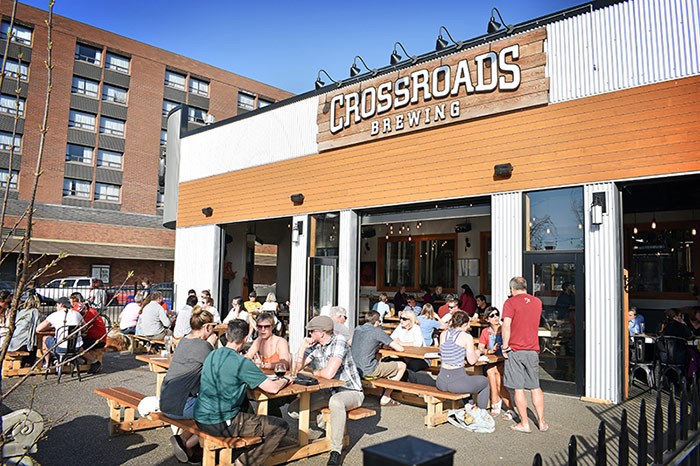 Photo: Rob Mangelsdorf
Photo: Rob Mangelsdorf
CrossRoads Brewing, which celebrated its first birthday in March, has been a big part of that change. Located in a former service station that had been vacant for years, Crossroads’ impressive downtown patio is now a hive of social activity, bringing life to a once empty block.
“We’re passionate about our community, so we wanted to do something for downtown,” says co-owner Bjorn Butow. “We want to make this city liveable.”
To that end, Crossroads will be holding a street festival series this summer, with live music, craft beer, street food and interactive outdoor party games.
Butow and business partner Daryl Leiski—who’s a local ER doctor—tapped Central City’s Gary Lohin to help them set up the brewery, while former Howe Sound brewer Patrick Moore is heading up the brewing duties.
The Cloud 9 Witbier (4.4% ABV, 12 IBU) was originally intended to be a summer seasonal, but it sold so well it’s become a year-round mainstay. A classic take on the refreshing Belgian style, the requisite orange and coriander are in perfect harmony here.
Food is by no means an afterthought at Crossroads, with stone-fired pizzas made with local ingredients available from their open concept kitchen.
“We’re a brewery first, but we want the food to complement that,” says Butow. “And nothing pairs better with beer than pizza.”
Amen to that!
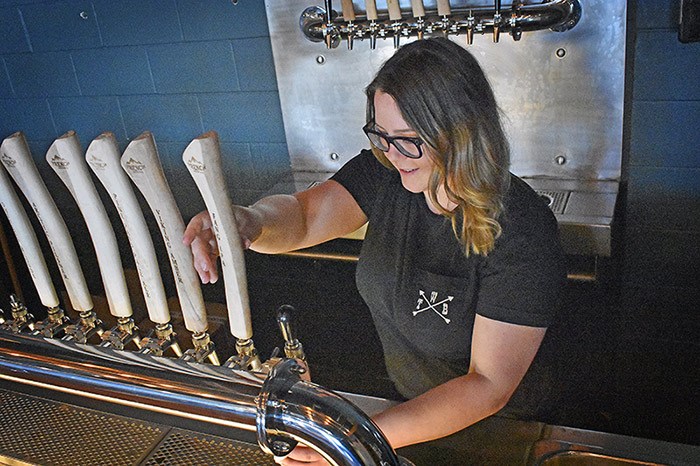 Photo: Rob Mangelsdorf
Photo: Rob Mangelsdorf
Not far from CrossRoads is Prince George’s newest craft brewery, Trench Brewing and Distilling, which opened in April. Whereas CrossRoads has more of a brewpub feel, Trench, with its location in the gritty, industrial east end of downtown, feels straight out of East Van. The tasting room is anything but gritty, however, with big communal tables, lots of local timber and stylish antler-based décor.
Co-owner Bailey Hoefels says that while craft beer is relatively new in Prince George, the locals are lining up to get their growlers filled.
“We’ve had so many homebrewers come in our first week, so there’s a huge interest in craft beer here,” she says. “It’s definitely going to keep growing.”
Pine Pass Pale Ale (5.0% ABV, 40 IBU) was my favourite out of Trench’s lineup; a hazy, hoppy citrus-forward pale with a welcome touch of lingering sweetness, the perfect thing for those long northern summer nights.
Rocky Mountain High
Here’s the thing about Northern B.C.: it’s not actually the north, it’s the middle. Prince George is close to the geographical centre of B.C., and there’s still literally half a province to the north, hiding away up there.
Heading north over the Rockies takes us through scenic Pine Pass and into Peace River country, AKA B.C.’s Alberta. We’re so far north here that come late June, the sun sets for maybe an hour or so, and it never really gets that dark. The long hours of summer sunshine are perfect for growing malting barley, making the Peace one of the biggest barley producing regions in North America. Those endless rolling fields of grain will end up as beer, all over the world.
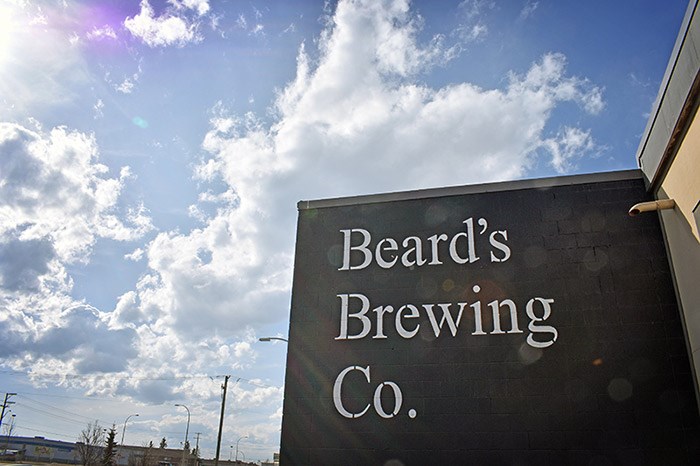 Photo: Rob Mangelsdorf
Photo: Rob Mangelsdorf
It’s kind of surprising craft beer didn’t catch on sooner up here. That said, Fort St. John is making up for lost time in a major way. Beard’s Brewing Co., the region’s first craft brewery, opened in November, and Mighty Peace Brewing Co. is set to open any day now.
At Beard’s, the bay doors were flung open to the prairie sunshine while locals lined up for growler fills on the day I visited the modest nanobrewery. Black Beard (4.8% ABV, 22 IBU), a well-balanced stout with notes of coffee and chocolate, stood out for its smooth, approachable character. Truly a dark beer for people who don’t like dark beers… yet.
Currently Beard’s is the northernmost craft brewery in B.C., but that will change once Mighty Peace opens (it’s two blocks north). Owner Scott Spence grew up on Vancouver Island, and like many in Fort St. John, came to work in the oil and gas industry. He brought his love for craft beer with him, and instead of being frustrated at the lack of craft beer options in his new home, he decided to do something about it, and open his own brewery.
With its 1,800-litre brewhouse, Mighty Peace will be the biggest craft brewery in the north, and will be expanding into distilling in the near future. Adam Keele, formerly of Midnight Sun Brewing in Anchorage, Alaska, is handling the brewing duties, so I’ll definitely be keeping this brewery on my radar.
After the Gold Rush
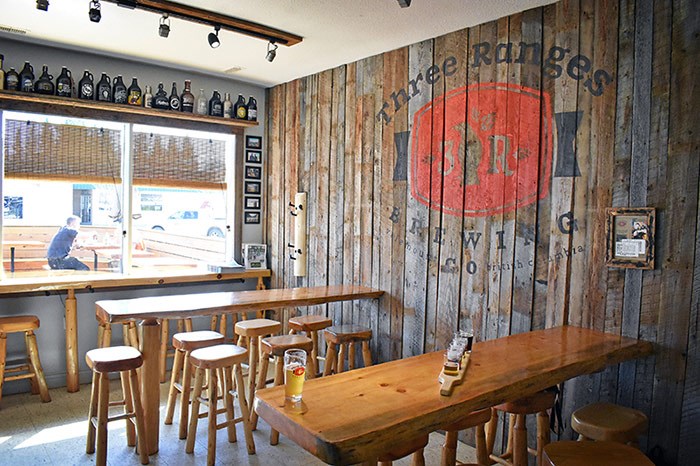 Photo: Rob Mangelsdorf
Photo: Rob Mangelsdorf
Having reached the northernmost brewery in B.C., we headed south again, stopping in the picturesque, if somewhat isolated, town of Valemount. Here, Michael Lewis of Three Ranges Brewing works tirelessly to keep the beer flowing, regularly brewing three or four times a day on his tiny 300-litre system. A retired US Army veteran, Lewis clearly comes by his work ethic honestly.
Despite only having a population of 1,000, Valemount has embraced Three Ranges in a big way.
“The tasting room has really become a gathering place for the community,” says Lewis. He gives back to the community too, with partial proceeds of his sales going to local charities and veterans groups.
Up Swift Creek Pilsner (4.7% ABV, 30 IBU) is one of Lewis’s original beers, and still one of the favourites. This hop-forward pilsner has a distinctly Northwest character, with floral, herbal hop notes, B.C. malt and a clean, crisp finish.
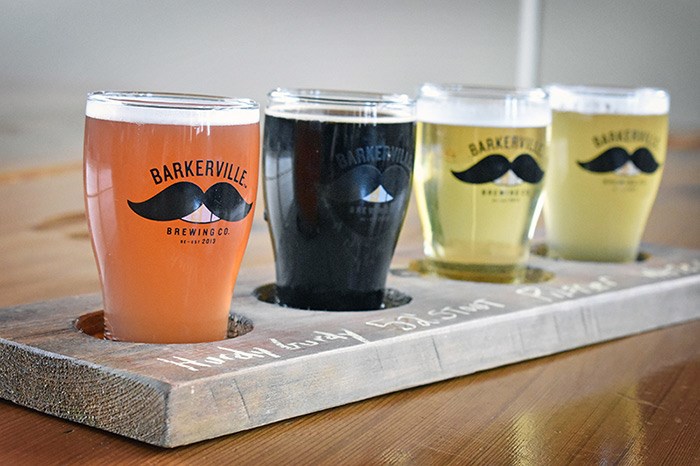 Photo: Rob Mangelsdorf
Photo: Rob Mangelsdorf
Following the Fraser River downstream along the Cariboo Gold Rush Trail is the quaint town of Quesnel and Barkerville Brewing, which takes its name from the nearby ghost town/tourist attraction. The gold rush theme is evident throughout the welcoming tasting room with pioneer relics and a rustic wooden communal table dominating the room.
The Hurdy Gurdy Hibisicus (4.6% ABV, 32 IBU) pays homage to Barkerville’s hurdy gurdy girls and was originally brewed as a Pink Boots Brew for International Women's Day back in March. Flavoured with hibiscus and dry-hopped with El Dorado, it’s a tart, floral, citrusy treat.
When Barkerville first opened in 2013, the locals likely would have beer leery of such flavourful fare.
“We’re five years into educating the market, so things have changed,” says general manager Justine Pelletier. “We don’t have to explain what growlers are anymore.”
In 2016, Barkerville won two golds and bronze at the B.C. Beer Awards, sending the message that northern beer was not to be ignored.
However, after years of trying to break into the crowded craft beer market in southern B.C., Pelletier says they are concentrating their efforts on the north now. The strategy seems to be working; storefront sales at Barkerville were up 77 per cent last year.
Less than an hour to the east into the Cariboo Mountains is the brewery’s namesake: the historic town of Barkerville. Founded in 1862 during the Cariboo Gold Rush, the entire town has been painstakingly restored with working hotels, restaurants, churches, blacksmith shops—even a printing press. Barkerville is a completely immersive experience, with actors in period garb playing the roles of the town’s actual former residents. Along with the charmingly artsy town of Wells right next door, Barkerville is absolutely worth the side trip—if not a trip of its own.
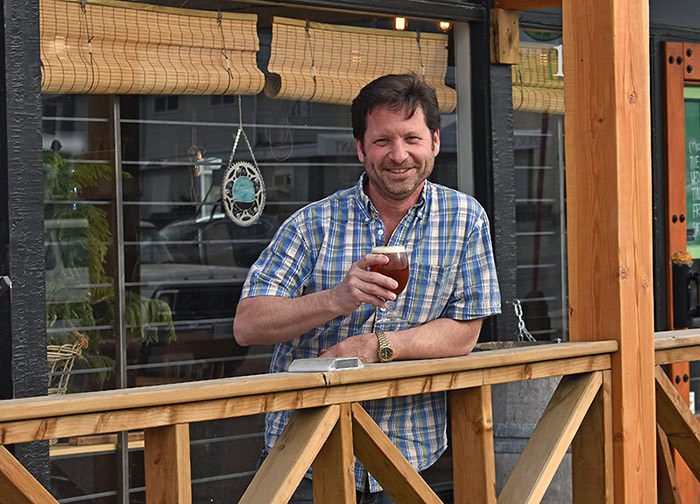 Photo: Rob Mangelsdorf
Photo: Rob Mangelsdorf
As we continue on towards Jackson’s Social Club and Brewhouse in 100 Mile House, the startling aftermath of the 2017 Plateau wildfire becomes evident in the blackened hillsides scarred landscapes. At its height, the fire covered more than 4,500 sq. km and forced the evacuation of tens of thousands of Cariboo residents—including owner Keith Jackson, who had to abandon his brewery for a week.
“I was lucky,” he says. “But I had to get special permission to come back into take care of my beer.”
Thankfully, the brewery never lost power, and the beer was saved.
Located at the site of the mercifully short-lived Broke ‘N Road Brewing, Jackson’s might have the best location in town, right on Hwy 97. With a brand new patio (built by Jackson, himself), this summer is will no doubt be packed this summer.
The Giddy Up Brunette (4.6% ABV, 28 IBU) is a brown ale made with organic Mexican coffee beans, roasted by Jackson, himself. Smooth and well-balanced, the coffee notes were nicely balanced by the slightly sweet malt character.
With the sun starting to sag low, we continued along the highway, and as we came down off the plateau and into the familiar dry valleys of the Thompson, we soon realized we were almost home. In many ways, Northern B.C. seems a lot further away than it actually is—and that’s a big part of the appeal.
The final frontier is closer than you think.
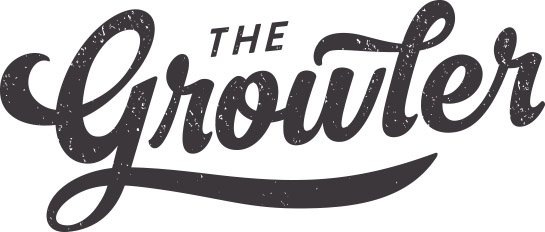 The Summer 2018 issue of The Growler is out now! You can find B.C.’s favourite craft beer guide at your local brewery, select private liquor stores, and on newsstands across the province.
The Summer 2018 issue of The Growler is out now! You can find B.C.’s favourite craft beer guide at your local brewery, select private liquor stores, and on newsstands across the province.


